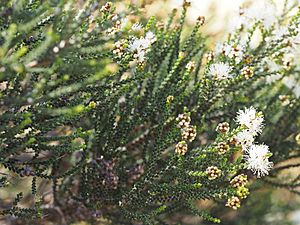Melaleuca cucullata facts for kids
Quick facts for kids Melaleuca cucullata |
|
|---|---|
 |
|
| M. cucullata leaves, flowers and fruit | |
| Scientific classification | |
| Genus: |
Melaleuca
|
| Species: |
cucullata
|
Melaleuca cucullata is a large shrub that belongs to the myrtle family, called Myrtaceae. This plant is special because it is endemic, meaning it only grows naturally in the south-west part of Western Australia. Its name, cucullata, comes from the shape of its leaves, which look a bit like tiny academic hoods.
Contents
Discovering Melaleuca cucullata
Melaleuca cucullata is a bushy shrub with branches that arch over. It can grow to be about 4.0 m (10 ft) tall. Its leaves are small, thick, and shaped like a dish. They are about 1.7–5 mm (0.07–0.2 in) long and 1.2–2.6 mm (0.05–0.1 in) wide. Sometimes, the leaves grow in opposite pairs. Other times, they grow one after another along the stem.
This plant produces many flowers. These flowers grow in clusters at the ends of the branches. The branches keep growing even after the flowers bloom. Each cluster has between 4 and 10 groups of three flowers. These clusters are about 15–18 mm (0.6–0.7 in) long and 15 mm (0.6 in) across. The petals are small, about 1.3–1.5 mm (0.05–0.06 in) long. They fall off as the flower opens. The flowers have pure white stamens. These are the parts that hold pollen. They are arranged in groups of five around the flower. Each group has 5 to 9 stamens. The main time for flowering is spring. After the flowers, woody capsules (seed pods) form. They are tightly packed and oval-shaped.
Naming and History
This plant was first officially described in 1852. It was named by a Russian botanist named Nikolai Turczaninow. He published his description in a scientific paper. The specific part of the name, cucullata, comes from the Latin word cucullus. This word means "hood." It refers to the plant's leaves, which look like small hoods.
Where It Grows
You can find this melaleuca plant in specific areas of Western Australia. These areas include the districts around Lake Grace, the Stirling Range, and Israelite Bay. It grows in certain biogeographic regions. These include the Coolgardie, Esperance Plains, and Mallee regions. This plant likes to grow in clay soils and loam. Loam is a type of rich soil. You can find it on hillsides and flat areas.
Conservation Status
Good news for Melaleuca cucullata! The Government of Western Australia's Department of Parks and Wildlife has listed it as "not threatened." This means the plant is not currently in danger of disappearing.
Images for kids
-
M. cucullata growing near Ravensthorpe



